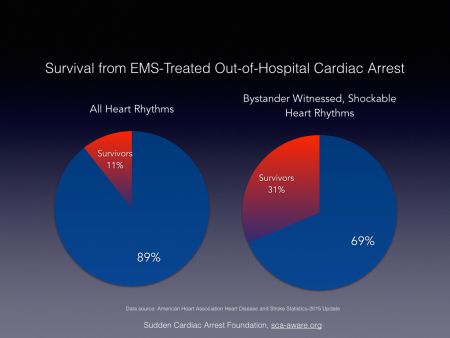
New report suggests the incidence of out-of-hospital cardiac arrest is 326,200. The average survival rate is 10.6% and survival with good neurologic function is 8.3%. Nearly one in three victims survives when the arrest is witnessed by a bystander.
 DALLAS, TX--For the first time in the 50 years that the American Heart Association/ American Stroke Association has released an annual snapshot of heart disease and stroke statistics in the United States, the new report adds a global view.
DALLAS, TX--For the first time in the 50 years that the American Heart Association/ American Stroke Association has released an annual snapshot of heart disease and stroke statistics in the United States, the new report adds a global view.
Health data compiled from more than 190 countries show heart disease remains the No. 1 global cause of death with 17.3 million deaths each year, according to “Heart Disease and Stroke Statistics — 2015 Update: A Report From the American Heart Association.” That number is expected to rise to more than 23.6 million by 2030, the report found.
What is Sudden Cardiac Arrest?
There are a number of ongoing challenges to understanding the epidemiology of cardiac arrest in the U.S. Despite being a leading cause of heart disease death, there are currently no nationwide standards for surveillance to monitor the incidence and outcomes of cardiac arrest. In addition, it is challenging to define what is “unexpected” or “sudden” death.
Sudden cardiac death has been defined as unexpected death from a cardiac cause that occurs within one hour of symptom onset (witnessed) or within 24 hours of last being observed in normal health (unwitnessed). However, this definition is difficult to apply in the real-world setting.
Despite these challenges, the latest statistics on OHCA provide valuable insights. Following are some highlights.
Report Highlights
Adults
Incidence
- The incidence of EMS-assessed OHCA in the U.S. is 326,200.
- Approximately 60% of OHCA are treated by EMS personnel.
- 25% of EMS treated OHCA have no symptoms before the onset of arrest.
- Among EMS-treated OHCA, 23% have an initial rhythm of VF or VT.
- The median age for OHCA is 66 years.
- Cardiac arrest is witnessed by a bystander in 38.7% of cases and by an EMS provider by 10.9 percent of cases. It is unwitnessed in 50.4% of cases.
- The majority of OHCA cases occur at a home or residence (69.5%).
Risk factors
- The incidence of OHCA per 10,000 adults is 10.1 among blacks, 6.5 among Hispanics and 5.8 among whites.
- Prior heart disease is a major risk factor for cardiac arrest.
- A family history of cardiac arrest in a first-degree relative (parents, offspring, siblings) is associated with a two-fold increase in risk of cardiac arrest.
Aftermath
- Based on Resuscitation Outcomes Consortium data, survival to hospital discharge with any first recorded rhythm was 10.6% and survival after bystander-witnessed VF was 31.4% for patients of any age.
- Based on Cardiac Arrest Registry to Enhance Survival data, survival to hospital discharge with any first recorded rhythm was 10.6% and survival with good neurologic function was 8.3%. Survival after bystander-witnessed VF was 33%.
- Based on a study conducted in New York City, survival to 30 days after hospital discharge was more than twice as poor for blacks as for whites and survival for Hispanics was also lower for whites.
Children
Incidence and Risk Factors
- Approximately 6,328 individuals <18 years of age in the U.S. experience EMS-assessed OHCA in the U.S.
- Most sudden deaths in young athletes were attributable to cardiovascular disease. Of the cardiovascular deaths that occurred, 29% occurred in blacks, 54% in high school students, and 82% with physical exertion during competition/training. Eleven percent occurred in females, although this proportion has increased over time.
- A longitudinal study of students 17-24 years of age participating in National Collegiate Athletic Association sports showed that the incidence of non-traumatic OHCA was 1 per 22,903 athlete participant-years. The incidence of OHCA was higher among blacks than whites and among men than women.
- In the state of Minnesota between 1993 and 2012, the incidence of sudden cardiac death in high school athletes screened every three years with standard pre-participation evaluations was .24 per 100,000 athlete-years.
Aftermath
- Based on the Resusciation Outcomes Consortium data, survival to hospital discharge after EMS-treated non-traumatic cardiac arrest with any first recorded rhythm was 7.3%. Survival after bystander-witnessed cases with a first recorded rhythm of VF was 53.3%.
Summary compiled by Mary Newman, Sudden Cardiac Arrest Foundation
ORIGINAL SOURCE: American Heart Association Heart Disease and Stroke Statistics 2015 Update
